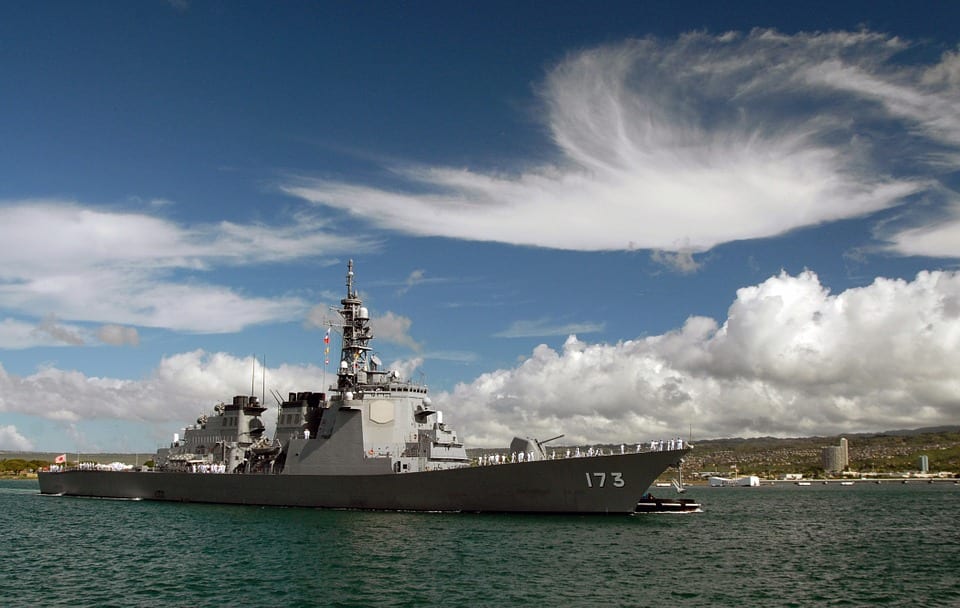Written by: Stephen Frantz ’20, Tower Center Undergraduate Research Fellow
On March 20, The Sun and Star Program had the honor of welcoming Professor Naoyuki Agawa, Admiral Tomohisa Takei, and Admiral Patrick Walsh to discuss the growing ties between the American and Japanese navies and celebrate the triumph of unity over hate. The two countries, once enemies, have moved beyond their bitter pasts to be militarily allied through their navies. As a result, both countries have both furthered their own interests and fostered more international cooperation among other countries.
Professor Agawa spoke first, providing an overview from the Japanese perspective of Japanese-American relations from the 1850s to the 1950s. In the 1850s, Commodore Perry traveled to Japan, kick-starting trade relations between the two countries. For the next 60 years, the two countries steadily grew in military and economic power. Following World War I, Europe was mostly in shambles; the only strong, developed countries left were the United States and Japan. At the Washington Naval Conference, held between 1921 and 1922 to diffuse tensions in East Asia, Admiral Kato Tomosaburo, Japan’s lead negotiator, took a generally pro-US stance; he wanted Japan to do whatever was necessary to avoid fighting a war with the United States. Yet, 20 years later, the two countries found themselves waging war with each other. Once the United States won, the Imperial Japanese Navy was disbanded. However, in 1952, Japan, aided by the United States due to pressure from the Cold War, established the Japan Maritime Self-Defense Force (JSMDF).
Joint military exercises, training, and other activities were performed by both navies together. Professor Agawa noted that soldiers on both sides of World War II had to put aside hard feelings towards each other and each other’s countries. After all, the intense fighting of the War, the memory of Pearl Harbor, and the detonation of two nuclear weapons on mainland Japan were significant and not easily put aside. Yet, after several years, tensions between both the soldiers and the two countries began to subside. Admiral Takei spoke of the resulting expansion of the Japanese-US naval presence in Asia after the Cold War ended. During the 1990s, a new threat arose: terrorism. As a result, that decade saw the US and Japan increase their naval presence in the Indian Ocean in order to stem the flow of terrorism.
Admiral Walsh continued the discussion of Japanese-US efforts to fight terrorism by examining the influence of the Japanese and American navies on the Middle-East. Many countries in the region joined Japan and the US in their fight against terrorism. For example, Pakistan got on the front lines of fighting terrorism once the two countries supplied the state’s ships with fuel. After seeing Pakistan join Japan and the US, Saudi Arabia began to participate in anti-terror operations, which led to the rest of the Gulf Cooperation Council (GCC) countries joining the United States. This new alliance of gulf countries included Kuwaiti soldiers, many of whom were former prisoners-of-war in the Gulf War. Interestingly, they were now cooperating with their former Iraqi captors. Similar to the United States and Japan, two countries, once bitter enemies, began working together.
To conclude his talk, Walsh spoke of US aid to Japan during the Fukushima nuclear disaster. Even though the plants at Fukushima operated mostly how they were supposed to, the sheer force of the earthquake did so much damage that Japan and the US had to consider mass evacuations from the area. Because there was no water going to the spent reactor fuel at the plants, those plants could have undergone a reaction that sent radiation into the air, water, and soil of Japan, which would have created another major catastrophe. However, 50 men from the two countries used buckets of sand to prevent the reactions from occurring, essentially saving Japan from a worse fate.
The United States and Japan have come a long way since World War II. Once fierce enemies, the two countries are now strong allies with similar geopolitical interests. Other forms of interdependence could soon follow, like free trade, that will push the two countries’ interests closer together. Whatever the future may hold, the US-Japan alliance appears to be here to stay.
